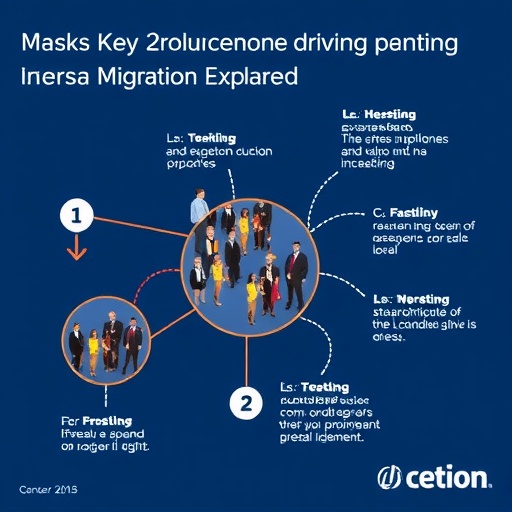In a world where migration patterns are constantly evolving, a recent systematic review sheds light on the professional factors influencing internal migration. The review, authored by Dias et al., highlights the complex interplay of professional environments, economic factors, and individual motivations, revealing crucial insights into why people choose to relocate within their own countries. This comprehensive study published in the Journal of Population Research, aims to provide a foundational understanding of the significant elements driving internal migration decisions and their broader implications on social and economic landscapes.
Internal migration has become an increasingly relevant topic in recent years, as urbanization accelerates and job opportunities fluctuate across regions. The authors, Dias, Cruz, and Luís, delve deeply into how professional environments impact the migratory decisions of individuals. They assert that understanding the professional motivations behind migration can illuminate broader social dynamics and trends, influencing everything from urban development to labor market policies.
According to the review, economic opportunities stand prominently among the driving factors of internal migration. Individuals often move from areas with limited job prospects to regions offering more favorable employment opportunities and higher salaries. This economic rationale is not merely about salary figures but also encompasses factors like job stability, career advancement, and the availability of specialized job markets. By examining these professional motives, the authors aim to generate dialogue on how regional economic disparities can affect migratory trends.
Moreover, the study illuminates the role of workplace environments in influencing relocation decisions. Many professionals find that a supportive work culture, opportunities for professional development, and networking prospects are significant incentives that encourage them to migrate. The authors argue that organizations that prioritize employee satisfaction and growth create environments conducive to attracting talent from different regions. Hence, businesses aiming to expand or retain talent must consider these factors in their operational strategies.
In examining the literature on internal migration, Dias and colleagues also note that personal motivations intertwine with professional factors to shape migration decisions. Individuals often weigh personal aspirations and lifestyle choices alongside their professional ambitions. For instance, a person’s desire to live in a vibrant urban center with cultural amenities may drive them to relocate, even if their current job situation is satisfactory. This highlights the need for policies that recognize the symbiotic relationship between personal fulfillment and professional opportunities.
Furthermore, the review outlines how demographic factors such as age, education, and family status influence the decision to migrate. For instance, younger individuals, often seeking educational and career opportunities, are more likely to relocate than older individuals who may prioritize family stability. The authors emphasize that understanding these demographic influences is crucial for policymakers who seek to address and manage the societal impacts of internal migration.
The investigation led by Dias et al. also delves into urban versus rural migration trends. Many individuals are moving from rural areas to urban centers in pursuit of jobs and lifestyle improvements, which can lead to significant socioeconomic shifts. The authors caution that while urbanization can drive economic growth, it can also lead to challenges such as overcrowding, strained infrastructure, and increased demand for services. Consequently, this presents a dual challenge for governments aiming to harness the benefits of migration while managing its burdens.
As the review progresses, it highlights the importance of regional and local policies in shaping migration trends. The findings suggest that governments play a pivotal role in either facilitating or hindering migration through taxation policies, housing availability, and investment in infrastructure. By creating an enabling environment that supports both businesses and migrants, localities can cultivate sustainable growth and stability.
The authors caution against a unilateral approach to addressing migration. Instead, they advocate for targeted policies that recognize the unique needs of diverse professional groups. Tailoring strategies to specific industries or demographic groups can create a more equitable migration process that benefits both migrants and host communities. The call for nuanced policy solutions is underscored by the diverse motivations that individuals have for relocating.
The implementation of such policies is an urgent necessity, as the review also emphasizes the consequences of failing to address the driving forces of migration. Regions that are resistant to change, whether through restrictive policies or lack of investment in local economies, risk falling behind in the ever-globalizing economy. By recognizing and adapting to the professional drivers of internal migration, policymakers can foster resilience and adaptability in the face of ongoing demographic shifts.
Additionally, Dias and colleagues stress the need for further research into the psychological aspects of migration. Understanding the emotional factors that accompany relocation decisions can provide richer insights into how individuals cope with change and adaptation in their new environments. This psychological dimension is vital for crafting support programs and resources that assist migrants in their transitions, ultimately aiding in their integration into new communities.
In conclusion, the systematic review conducted by Dias et al. represents a significant contribution to our understanding of the professional factors influencing internal migration. By dissecting the complex interplay between economic opportunities, workplace environments, and demographic influences, the authors provide a roadmap for effective policymaking that supports both individual aspirations and economic growth. Their findings underscore the necessity of recognizing the evolving nature of migration trends and the importance of innovative and adaptive policies that respond to these changes.
Ultimately, as societies increasingly grapple with the effects of internal migration, the insights generated by this comprehensive review offer a beacon for future research and policy discourse. By acknowledging the intricate motivations behind migration, nations can harness the potential of their mobile workforce to build vibrant, resilient economies that adapt to the evolving global landscape.
Subject of Research: Professional factors influencing internal migration.
Article Title: Professional factors influencing internal migration: a systematic review.
Article References:
Dias, S., Cruz, B., Luís, S. et al. Professional factors influencing internal migration: a systematic review.
J Pop Research 42, 39 (2025). https://doi.org/10.1007/s12546-025-09390-1
Image Credits: AI Generated
DOI: 10.1007/s12546-025-09390-1
Keywords: Internal migration, professional factors, economic opportunities, workplace environments, demographic influence, policymaking.




